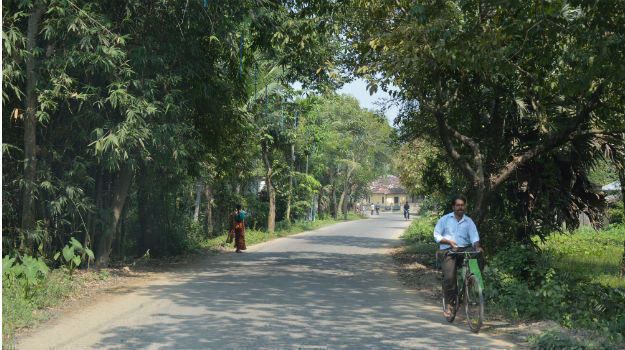PIN 711324 Area 40 ha Area code 03214 | Time zone IST (UTC+5:30) Telephone code 03214 Local time Saturday 2:34 PM | |
 | ||
Weather 34°C, Wind S at 21 km/h, 60% Humidity | ||
Samta (pronounced: [ʃaːmt̪ aː]) is a village and a gram panchayat in the Howrah district of the Indian state of West Bengal, on the banks of the Rupnarayan River.
Contents
- Map of Deulti West Bengal 711303
- History
- Geography
- Culture
- Education
- Transport
- House of Sarat Chandra Chattopadhyay
- References
Map of Deulti, West Bengal 711303
History
Samta's history dates back to centuries. During British Raj Samta was ruled by the Roys, who were the Zamindars of the village, subordinate to the Bardhaman Raj Estate, in turn subordinate to the British Empire.
After India attained independence, Zamindari was abolished and the village was taken over by the Government of India.
Geography
Samta is located on the fertile plains of the Rupnarayan River. It is situated about one kilometer (0.62 miles) away from the banks of the river.
Culture
The majority of the village's population is Hindu. Festivals such as Dol Jatra, Durga Puja, Bengali New Year, Kali Puja, Neel Shashti, Shivaratri, Shitala Puja, Saraswati Puja, Itu Puja, Janmashtami and other Hindu religious festivals are celebrated with great pomp and show. Gajans are also held in the village.
Madangopal Jiu Temple, a temple built in the 17th century, is situated in Mellock, a nearby village located south of Samta. It is locally known as Gopaler Mondir (meaning, the temple of Gopala). It was erected by Mukundaprasad Roychowdhury, a member of the family of Mellock's Roychowdhury Zamindars.
An annual fair-Sarat Mela is held in late January in the neighbouring village north of Samta, Panitras, in remembrance of Sarat Chandra Chattopadhyay, a Bengali novelist and short story writer of the Bengali renaissance. Sarat Mela was started in 1972.
Education
There are very few schools in Samta such as Samta Sarat Chandra Uccha Balika Bidyalay, Samta Primary School. More schools could be found the neighbouring villages, which includes- Panitras High School (H. S.), Children's Institution and Vivekananda Institution in Panitras. However, no college has been so far established in Samta and its neighbouring villages. The education seekers have to travel to Bagnan to have higher educations.
Transport
The village is linked to the NH 6, also known as Mumbai/Bombay Road, through a narrow road known as Sarat Road. The highway links it to other places including Kolkata, the state capital. The roads of the village are unmetalled and are made of bricks. There is also a barrage, a kind of breakwater created to protect the villages from floods. The barrage, the unmetalled roads and the Sarat Road links it to the nearby villages. Th Sarat Road further leads to Kalyanpur and Hooghly in the north, called the "Sarat Road".
The census town of Kolaghat, where the Kolaghat Thermal Power Plant is situated, is close to Samta and is linked by NH 6. Other nearby villages to Samta are Mellock, Panitras, Birampur, Gobindopur, Baraberia, Kankte, Mashiara, Kalyanpur, Amrajor, Mankur and Dakaberia.
The local transports exists in the form of rickshaws, rickshaw-vans and trekker (a kind of jeep).
The Deulti Station is one of the oldest stations of the South Eastern railway in India and was built in 1890.
House of Sarat Chandra Chattopadhyay
Sarat Chandra Chattopadhyay, a Bengali novelist and short story writer of the Bengali renaissance lived in Samta for many years. He was born into poverty in Debanandapur, Hooghly, but he spent the later years of his lifetime in Samta after living in Shibpur. His house in Samta is shown as Sarat Chandra Kuthi, on the map of Samta. He had good bonds with the fishermen and washermen of the village, who were considered to be of low class. So the Zamindar separated him from the village and demarcated the area surrounding his house. And the place where he lived came to be known as Samtaber. However, he was revered by the locals.
Then the banks of the Rupnarayan river used to be very close to his house. But later the river changed its course and moved further away. While living here Sarat Chandra penned up several novels such as Abhagir Swarga, Kamal Lata, Shesh Prashna, Palli Samaj, Ramer Sumati, Pather Dabi and Mahesh.
His two-storied Burmese style house was also home to Sarat Chandra's brother Swami Vedananda, who was a disciple of Belur Math. The trees of bamboo and guava planted by him still stand in the garden of his house. His house draws many tourists every year from places such as Kolkata.
It was declared as a Heritage or Historical Site by the Clause 2 of the West Bengal Heritage Commission Act 2001 (Act IX of 2001). In 2009 the whole house underwent renovation and beautification.
